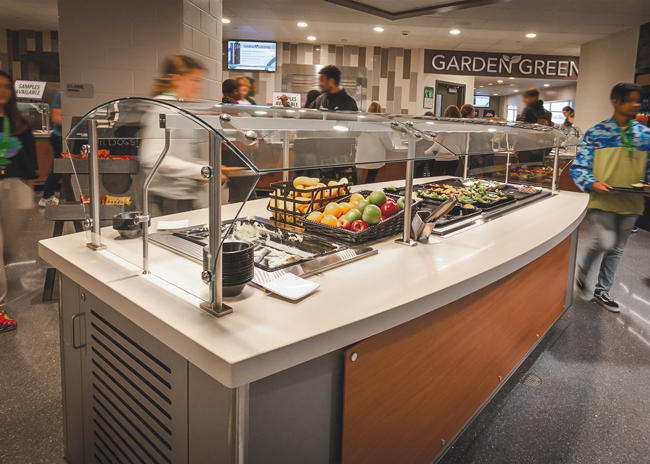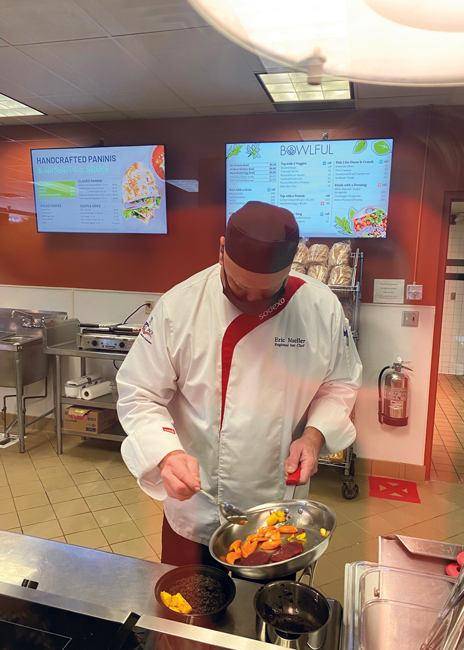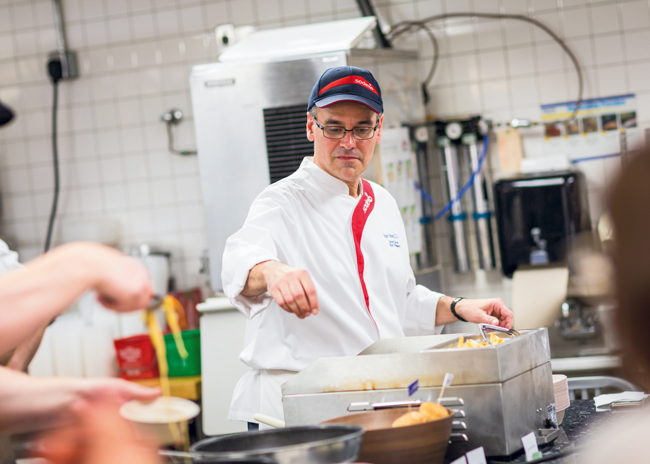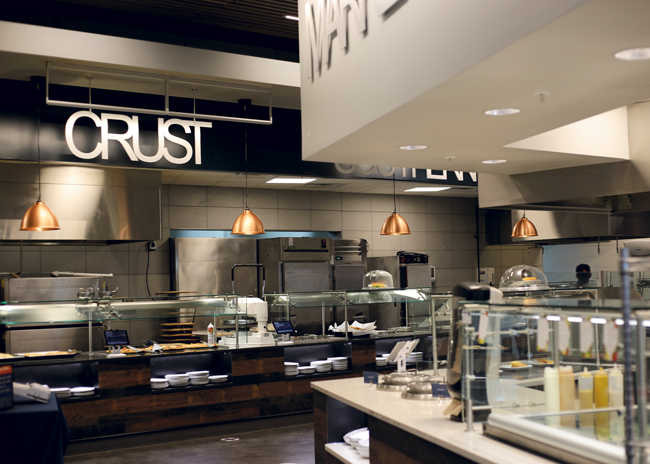The food station has become a standard design component of many foodservice operations over the past few years.
It’s a particular favorite with those segments that have a fairly stable base of daily customers, such as college/university or corporate dining, because it allows the operator to offer a variety of menu options in one location while leveraging staff and other operational efficiencies.
As the U.S. slowly moves out of pandemic restrictions, though, many foodservice professionals continue to wonder what the future holds for food stations.
Surviving the Pandemic
 One consideration in enhanced sanitation efforts at a salad bar setup is to have one set of tongs for each person going through that line, suggests Chris Wair, Reitano Design Group. Here, a pre-pandemic look at the salad station setup at Brownsburg High School in Brownsburg, Ind.As in every other area of foodservice, operators with food stations have had to demonstrate their adherence to sanitation protocols more than ever. Scott Reitano, principal of Reitano Design Group in Indianapolis, likes to use the term “cleanliness theater” to define what operators need to do. “As they go through a food station, you have to be showing people what the steps are you’ve taken to protect their health and the integrity of the food,” he says.
One consideration in enhanced sanitation efforts at a salad bar setup is to have one set of tongs for each person going through that line, suggests Chris Wair, Reitano Design Group. Here, a pre-pandemic look at the salad station setup at Brownsburg High School in Brownsburg, Ind.As in every other area of foodservice, operators with food stations have had to demonstrate their adherence to sanitation protocols more than ever. Scott Reitano, principal of Reitano Design Group in Indianapolis, likes to use the term “cleanliness theater” to define what operators need to do. “As they go through a food station, you have to be showing people what the steps are you’ve taken to protect their health and the integrity of the food,” he says.
Chris Wair, design principal at Reitano Design Group, says enhanced sanitation efforts can start with something as simple as having separate sets of equipment for staff at the station. “If you have a salad bar,” he says, “you devise a way that says, ‘Joe, you’re going to have your own set of tongs and you’re going to use it all the way through. Then, Mary, you’re going to have your own set of tongs.’ ”
Many of those steps are easy to execute and retain the integrity of the food station experience. The most visible examples — breath guards and plastic dividers — have become virtually ubiquitous at food stations. Kris Morphis, president of KRM Food Service Design & Consulting in Charlotte, N.C., has seen stations “where they’re adding an additional two or three feet [of distance] through some tensile barriers in front of the serving counter, so they have that six feet of space between the customer and staff member.”
Staffing of food stations, however, represents an aspect not so easily covered during the pandemic. With staff reduced due to illness or budgetary restraints, “where you thought you needed two or three people to handle the station, now you’re trying to figure it out with one or two people,” says John Franke, president of Franke Culinary Consulting in Dallas.
 Sodexo’s Rob Morasco, CEC, Sodexo North America, seen here at the College of Saint Rose in Albany, N.Y., believes as food stations reemerge, the variety of menu items produced at each station may change a bit versus in the past having two different stations executing those menu concepts.Because of the decreased number of staff and/or customers, many operations reduced the number of menu items they offer. That can lead to some tough decisions, according to Nona Golledge, principal, marketing and operations for Bakergroup, a foodservice consulting and design firm in Grand Rapids, Mich. “Reducing stations may result in less variety of options,” she says. “To keep customer satisfaction at a high rate, operators will need to consider how to accommodate menu variety with varying styles of service, such as grab-and-go options and perhaps a delivery component — all within budget constraints.”
Sodexo’s Rob Morasco, CEC, Sodexo North America, seen here at the College of Saint Rose in Albany, N.Y., believes as food stations reemerge, the variety of menu items produced at each station may change a bit versus in the past having two different stations executing those menu concepts.Because of the decreased number of staff and/or customers, many operations reduced the number of menu items they offer. That can lead to some tough decisions, according to Nona Golledge, principal, marketing and operations for Bakergroup, a foodservice consulting and design firm in Grand Rapids, Mich. “Reducing stations may result in less variety of options,” she says. “To keep customer satisfaction at a high rate, operators will need to consider how to accommodate menu variety with varying styles of service, such as grab-and-go options and perhaps a delivery component — all within budget constraints.”
Those changes in staffing and menu often dovetail. Rob Morasco, CEC, senior director of culinary development for Sodexo North America in Gaithersburg, Md., says that even as staff start to return to some locations, choices have to be made regarding what menu items they can produce at each station. “I don’t think we can reduce the number of stations, but the variety in each station may change a little bit,” he says. This can be a particularly important consideration at locations with “captive audiences,” such as colleges, where a perceived lack of choice can result in boredom, thus leading students to dine off campus.
The equipment in each station may define what items staff can produce, Morasco says. Rather than struggling to offer a variety of items at each meal occasion, it might be a better move to start with an easily executable core menu, he says, and expand it based on what the equipment can do. Staff might use the griddle and fryer to serve a burger menu at lunch and then tacos during dinner. At each station, “it’s not necessarily about the cuisine anymore; it’s about the equipment,” he says.
That reduced menu can also offer a chance for creativity, says Franke, using the burger menu as an example. “You’ve got to keep the core of the burgers, but then you say,
‘I can do 30 different sauces for this.’ It’s keeping the SKUs down but innovating a little more,” he says.
Positioning for the Future
In many ways, many food station setups would seem to be perfectly positioned for a post-pandemic environment. First, many stations were designed to be self-sufficient, with refrigeration, cooking and storage equipment contained within the unit. “That’s a good thing for the times we’re living in now,” says Morphis, who feels self-contained stations can help reduce staff interaction. “Those two or four people operating that food station aren’t having to go back into the kitchen at all during the day. So when you’re working with that cluster of staff, you don’t have to worry about transmission to other staff.”
Since food stations bring the prep process right out front, they also help satisfy customers who want to know staff prepare their food to order, exactly the way they want it. “There’s no doubt that people want customization,” says Morasco. “They want to see what’s being prepared for them and have a choice [in it],” he says. That customization doesn’t have to be extensive, he notes, and can also bring some visual interest to the station. “Even if it’s a simple entree like meatloaf and mashed potatoes, if you can figure out a way to carve the meatloaf to order, I think people appreciate that.”
Because of their compactness, food stations can be more flexible than regular kitchens, which represents an advantage when menus change or when operators reevaluate their offerings. “What we’re seeing — especially in B&Is and a little less in universities — is that the menu fluctuates in ethnicity, or in hot and cold food, at the same station, depending on what day it is,” Wair says. For that reason, consultants and designers working on new projects may shy away from single-purpose pieces of equipment for food stations, either keeping them in the main kitchen or swapping them out for pieces that can perform multiple functions.
The increase in online ordering has also forced some operations to think about their food stations differently in terms of flow and design. “The queueing line has shifted from having a line at the point of ordering to now the point of pickup,” Golledge says.
Because of this, many stations now feature a design that allows them to operate as stand-alone units, notes Wair. “We’re putting ticket rails now on stations that would have formerly been simply walk-through stations, and we’re doing a lot more ticket printers at stations,” he says.
Technology also helps reshape the way designers think about food stations, sometimes moving them closer to the concept of a pop-up. “Maybe it’s more about where you put a food station,” Reitano says. In a high school setting, for example, if the food station isn’t closely tied to the kitchen for production, students could order from an app and pick up the food in another wing of the building, he says. “So, a food station might not be attached to the kitchen, and it might not look like how we traditionally think of a food station, [but it’s] still the same operator, still quality food. The technology is helping with that.”
The best approach to take with a food station, says Franke, is to think of it as a “mini business.” Capitalize on the flexibility inherent in food stations, he says, “and be adaptable. People who haven’t adjusted or learned after all this time are going to be out of business. The smart people are still out there and are working hard to make changes.”

Food Stations at Auburn University
The college/university segment was one of the early adopters of the food station system. It was natural for generations who grew up with a plethora of choices readily available from mall food courts to expect the same variety once they went off to college. To meet these expectations, many university foodservice operations moved from traditional cafeteria-style lines to more “open court” settings using food stations. By making some minor adaptations in their food stations, colleges have found that they can adjust to the fluctuating student population sizes dictated by pandemic restrictions.
At the height of the pandemic, Auburn University’s dining rooms were closed as the university shifted to takeout-only foodservice. The food stations in the full-service Terrell dining hall effectively became production stations, says Glenn Loughridge, director of campus dining and concessions at Auburn University in Auburn, Ala.
“We were still using the dining hall and the food stations,” Loughridge says, “but we would be bringing [food] out to the front in a box.”
The school also installed automat-style food lockers as a way to transfer the food from the stations to the students in a reduced-touch method. “We used the food lockers to serve the food that normally would have come out of the stations, but we still use the stations as the mechanism to create the different experiences,” Loughridge says.
There was also some minor shifting of the menu, such as removing some of the items that took longer to produce or serve. “You could order a pizza, but maybe some of the other options that we would normally have — like a saute station — were not available,” Loughridge says. He also relied on his food stations to produce food for Auburn’s on-campus delivery service, which helped serve students who were quarantining or isolating due to COVID-19. He repurposed a station which had been used primarily for catering to serve the increasing delivery needs. “Catering has been down because of the pandemic,” he says, “and so utilizing that staff for delivery options made a lot of sense.”
As students gradually started to return to campus, Loughridge made some minor physical adjustments to food stations, such as installing hanging barriers for more separation between prep staff and students.
The Auburn operation is now nearly back to normal, Loughridge says. “We are 100% open. All the options we have on campus — including food trucks and dining halls — everything is in operation,” he says. Since some classes have temporarily shifted to a hybrid partly on-campus, partly off-campus schedule, though, he estimates that dining services is accommodating about 80% of its pre-pandemic volume.
“We’re very fortunate to be able to be mostly open at this point,” Loughridge says. “We’re excited to have students back.”
The Well-Equipped Food Station
 Food stations designed to be self-sufficient, such as this station at Earlham College in Richmond, Ind., may be well positioned for a post-pandemic environment.
Food stations designed to be self-sufficient, such as this station at Earlham College in Richmond, Ind., may be well positioned for a post-pandemic environment.
Depending on where they’re situated, food stations can often use standard cooking and refrigeration equipment with no problem. But foodservice designers have some recommendations for pieces that work particularly well in stations, especially on a stand-alone island or in a tight footprint.
“Equipment that allows for quick assembly of orders, such as sandwich or pizza refrigerated make tables, is ideal” for food stations, says Nona Golledge, principal, marketing and operations for Bakergroup, Grand Rapids, Mich.
“Based on our current experience, switchable food wells” are being used more often, says Chris Wair, design principal at Reitano Design Group, Indianapolis. “And we’re also looking at more of the ventless equipment. That’s going to allow a little more diversity in what you’re doing at the station,” he adds.
High-speed ovens, induction ranges and induction woks all rank highly with Rob Morasco, CEC, senior director of culinary development for Sodexo North America in Gaithersburg, Md. “Anything that enables you to deliver things quickly is a plus,” he explains.
Large pizza ovens can have a surprising amount of flexibility, making them a good choice for food stations, says Kris Morphis, president of KRM Food Service Design & Consulting in Charlotte, N.C. “There’s so many things you can do on that,” he says. “It’s not just pizza; you can cook your breads, pastas, meat, vegetables, all kinds of things. It’s a very big piece of equipment, but it’s also a flexible piece of equipment.”



